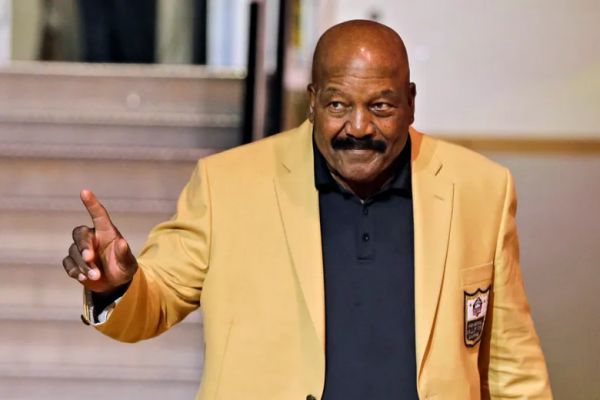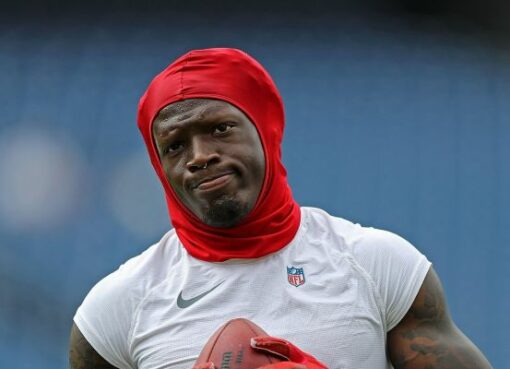Jim Brown, an unstoppable running back who retired at the pinnacle of his dazzling career to become an actor and a prominent civil rights activist in the 1960s, has passed away. He was 87.
Thursday night, Brown passed away peacefully in his Los Angeles residence with his wife Monique by his side, according to a family spokesperson.
“To the world, he was an activist, an actor, and a football superstar,” Monique Brown wrote in an Instagram post. “He was a devoted spouse, father, and grandfather to our family. Our souls are shattered.”
Brown was selected as the NFL’s Most Valuable Player in 1965 and shattered the league’s record books during his brief tenure from 1957 to 1965.
Brown led the Cleveland Browns to their final NFL championship in 1964 before retiring in his prime following the 1965 season to pursue a career as an actor. He has appeared in over thirty films, such as “Any Given Sunday” and “The Dirty Dozen.”
The arrival of Brown, a powerful runner with speed and endurance, sparked the game’s growing prominence on television.
As African-Americans fought for equality, Brown utilized his platform and voice to further their cause.
“I hope every black athlete takes the time to educate themselves about this incredible man and what he did to change all of our lives,” NBA superstar LeBron James said. “We all stand on Jim Brown’s shoulders. If you were Black and grew up in Northeast Ohio, Jim Brown was a god.
“As a young football-loving child, I viewed him as the finest Cleveland Brown to ever play. Then, as I began my own voyage as a professional athlete, I realized that his social accomplishments were the true measure of his greatness. When I decide to voice out, I always consider Jim Brown. I can only communicate because Jim helped me break down those barriers.”
In June 1967, Brown organized “The Cleveland Summit,” a meeting of the country’s top Black athletes, including Bill Russell and Lew Alcindor, who later became Kareem Abdul-Jabbar, to support boxer Muhammad Ali’s opposition to serving in Vietnam.
Later in life, he labored to reduce gang violence in Los Angeles and in 1988, he founded Amer-I-Can, a program that assists disadvantaged inner-city youth and ex-offenders.
“Jim Brown is a true icon of not just the Cleveland Browns, but the entire NFL,” said Dee and Jimmy Haslam, owners of the Cleveland Browns. He was undoubtedly one of the greatest players in NFL history and unquestionably the greatest player to ever wear a Browns uniform. Jim was one of the reasons why the Browns currently have such a large fan base.
“So many people grew up watching him dominate every time he stepped onto the football field, but his numerous honors on the field only tell a portion of his tale. Off the field, he should also be known for his dedication to making a positive impact on humanity as a whole.
On the field, there was no one like Brown, who would bulldoze through would-be tacklers, refusing to let a single man bring him to the ground before sprinting away from linebackers and defensive backs. He was also well-known for using a stiff arm to shrug off defenders in the open field or push them away like rag puppets.
Former President Barack Obama said,
“I was too young to remember Jim Brown’s playing days, but I was familiar with his legacy.” “In addition to being one of the finest football players of all time, he was also an actor and activist, speaking out on civil rights and encouraging other African-American athletes to do the same. Our sympathies are with Monique, Jim’s wife, and his children, as well as all those who knew and admired him.”
In fact, Brown was unlike any running back before him, and some believe that no one has ever been greater than Cleveland’s unmatched No. 32. At 6-foot-2 and 230 pounds, he was relentless in his pursuit of every yard, dragging multiple defenders behind him or finding openings where none appeared.
After being tackled, Brown would slowly rise and walk even more slowly back to the huddle before dominating the defense once he regained possession of the ball.
Roger Goodell, the NFL commissioner, offered condolences on behalf of the league.
Goodell stated,
“Jim Brown was not only a gifted athlete — one of the most dominant players to ever step foot on an athletic field — but also a cultural icon who helped promote change.”
During his nine-year NFL career, which coincided with the civil rights movement in the United States, he became a pioneer and model for athletes engaged in social initiatives outside of their sport.
Brown was an antagonistic figure off the field. While he had a soft place for those in need and his generosity changed lives, he was also arrested six times, primarily for assaulting women.
In June 1999, Brown’s wife called 911 to report that he had threatened to murder her and smashed her car with a shovel. During the trial, Monique Brown recanted her testimony.
Jim Brown was found not guilty of domestic threats but was found guilty of misdemeanor vandalism. Brown was sentenced to six months in prison when he refused to attend counseling for domestic violence.
Even though he played his entire career with Cleveland, he feuded with Browns coach Paul Brown and, subsequently, with the team’s management.
Brown moved to Hollywood after his playing career concluded and eventually settled there. Brown informed Cleveland head coach Blanton Collier of his retirement while he was filming “The Dirty Dozen” in England while the team was in training camp.
His filmography includes “100 Rifles,” and “Mars Attacks!” Spike Lee’s “He Got Game,” Oliver Stone’s “Any Given Sunday,” and his parody of the blaxploitation genre, “I’m Gonna Get You Sucka.”
In 2002, Jim Brown was the subject of Spike Lee’s HBO documentary, “Jim Brown: All-American.”
Brown’s relationship with the Browns has been inconsistent in recent years. He was recruited to advise the team’s younger players and served as a consultant to team owner Randy Lerner.
Brown left the club in 2010 after his role was diminished by the incoming team president, Mike Holmgren. Brown felt insulted by the perceived demotion; he skipped the unveiling of the “Ring of Honor” inside the club’s downtown stadium in protest.
In 2016, the Browns erected a statue of Brown in front of their stadium.
Brown was named to the All-Pro team eight times and attended the Pro Bowl in his nine seasons in the league. At the time of his retirement at age 30, Brown held the league records for yards (12,311) and touchdowns (126).
And despite his aggressive approach, Browns never missed a game, participating in 118 consecutive contests.
John Mackey, a Hall of Fame tight end, relates: “He told me, ‘Make sure whoever tackles you remembers how much it hurts.'” “He lived by this philosophy, and I have always adhered to it.”
Brown, a two-sport star at Syracuse and, according to some, the greatest lacrosse player in NCAA history, endured innumerable racist taunts while competing at the virtually all-white institution at the time. Nonetheless, he was an All-American in both disciplines and earned a basketball letter.
Brown was selected sixth overall in the 1957 draft and joined a team that routinely competed for the championship. During that season, he was the Offensive Rookie of the Year.
In 1958, Brown set a league record with 1,527 yards rushing and 17 touchdowns while running behind an offensive line that included Hall of Fame tackles Lou Groza and Mike McCormack. Before gaining 996 yards in 1962, he never ran for less than 1,257 yards in the following three seasons.
He lead the NFL in rushing eight times, gaining 1,864 yards in 1963, his career high. He averaged 104 yards per game, 106 touchdowns on the ground, and 5.2 yards per carry. Brown, a dangerous receiver, completed his career with 262 receptions for 2,499 yards and 20 touchdowns.
Gale Sayers, a Hall of Fame running back, once said,
“I’ve said it many times and I’ll say it again: Jim Brown is the best, and he will remain the best long after his records are broken.”
The Browns retired Brown’s No. 32 in 1971, the same year he was inducted into the Hall of Fame. However, he seldom visited Cleveland in the 1970s and 1980s.
Art Modell, the owner of the Cleveland Indians, and he were at odds over his unexpected retirement, but they subsequently reconciled and remained close friends.
In 1995, Brown supported Modell’s decision to relocate the Cleveland franchise to Baltimore. It was both an indication of his devotion to Modell and his intense independence. Brown was one of the few former Browns athletes who had no animosity towards Modell for relocating the team.
Numerous contemporary athletes lacked appreciation for Brown and his influence on American athletics.
Former Browns head coach Romeo Crennel stated,
“They came of age in a different era.” “He is one of the finest NFL players of all time, and what he was able to accomplish during his career is remarkable. I doubt that anyone could have achieved what he did in the manner in which he did it, given the circumstances in which he had to operate and the things he had to endure.
And the fact that he went out on top is something that few men are able to appreciate.
Brown, who was born on St. Simons Island, Georgia, on February 17, 1936, excelled in multiple sports at Long Island’s Manhasset High School. He averaged 14.9 yards per carry in football and once scored 55 points in a game.
Later, Brown took up golf, and in the 1963 Cleveland Pro-Am, while playing with Jack Nicklaus, he recorded a 79.
Monique and their infant are Brown’s survivors. After thirteen years of marriage, he divorced Sue Brown, with whom he had three children.
Also Read: Juan Williams Of Fox News Quits The Five! 43 Years Married Life





